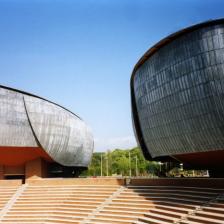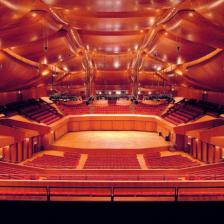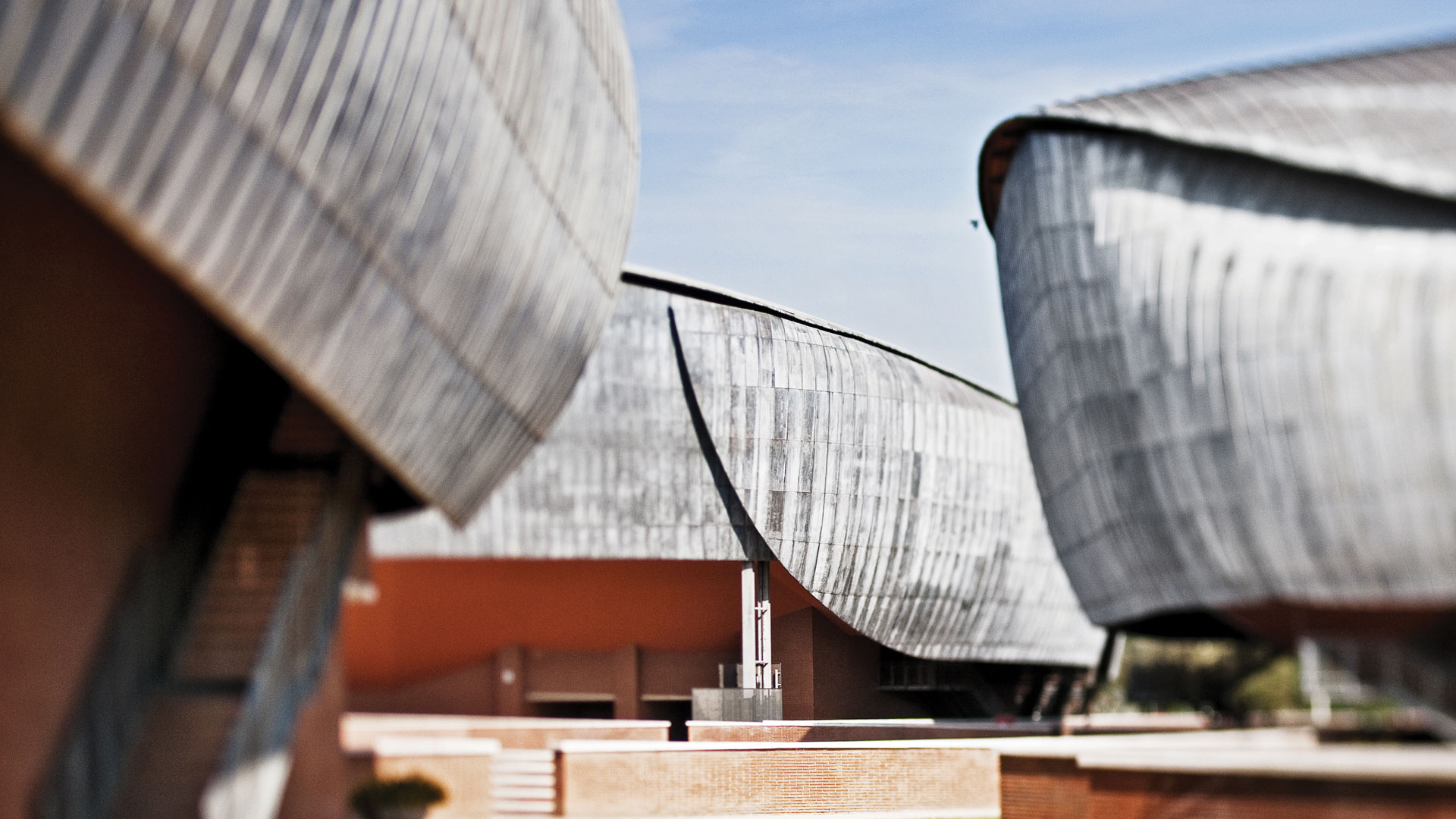
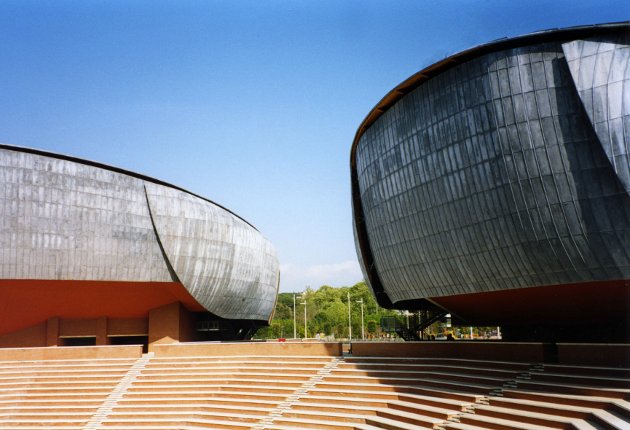
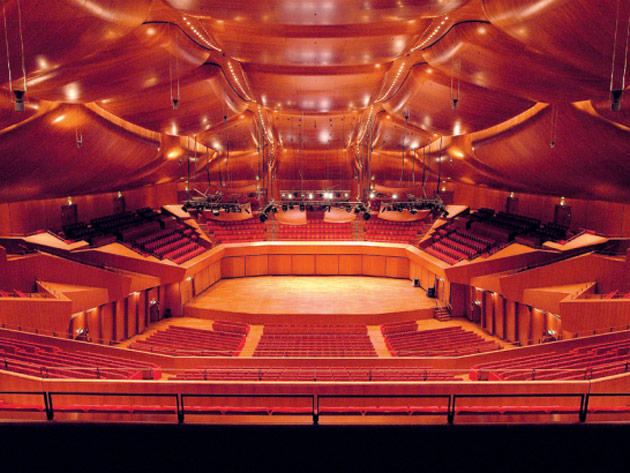
Designed by the arch star Renzo Piano, and delivered to the city on 21 December 2002, the Auditorium Parco della Musica of Rome is a large multi-purpose complex that welcomes all genres and artistic expressions to meet the demands of an increasingly vast and demanding public.
The three main halls, Santa Cecilia, Sinopoli, and Petrassi, are real "harmonic chests", gigantic musical instruments surrounded by a 30 thousand square meter hanging park enclosed between the banks of the Tiber river, the hill of the Parioli district, and the Olympic village.
All the colors and materials with which the Auditorium is built with recall Roman architectural tradition, from white travertine to red bricks, to the lead-gray of the most famous domes such as the Pantheon. Continuity between past and present that, in the Auditorium, coexist in perfect harmony.
Today, the Auditorium Parco della Musica has entered into the habits and hearts of the Romans and tourists, home of all music and all the arts, from theater to dance, from cinema to literature: a veritable factory of culture.
SPACES AND HALLS
Cavea - 2782 seats
The Cavea, named after Maestro Luciano Berio, is the central fulcrum of the entire complex. Its double function, of open-air theater and square, makes it a meeting point and a place increasingly inserted in the urban context.Exhibition Area - Parking
This exhibition area consists of 3,000 square meters on two levels, both connected to an external staircase and an internal access ramp. It is ideal for different exhibitions, stands, and catering spaces.
Foyer
The large foyer, which combines the accesses to the three halls, is not only a meeting and gathering point but also a multi-purpose area that houses the Risonanze exhibition space and the Archaeological Museum of the Auditorium.
Along the Foyer winds a luminous path of 20 installations, made with neon by the Tuscan artist Maurizio Nannucci. The work, which has a permanent character, was conceived and designed exclusively for the Auditorium Parco della Musica. Also along the Foyer are exhibited some Cellotex by the great artist Burri.
Guest room - 100 seats
In the heart of the foyer, this space is ideal for receiving guests and welcoming them in a comfortable and discreet environment. It is completely independent and has a bar, a wardrobe, and direct access to the Sinopoli Hall. The Guest Room is also suitable for smaller meetings, exhibitions, and press conferences.
Petrassi Hall - 673 seats
It's the smaller room, a real musical theater, with orchestra pit and equipped stage, and the possibility of changing the scene and costumes. The two short walls of the stage can rotate 90 ° creating a traditional proscenium with an Italian curtain to allow the representation of operas and theatrical performances.
Chamber, baroque, and symphonic concerts, theater plays, and films take place when the walls are closed thanks to the open scene. Since March 2016 it has effectively become a movie theater.
Sinopoli Hall - 1133 seats
This hall mainly houses symphonic and chamber music. It is characterized by the great versatility of the stage which offers the possibility of hosting dance shows, concerts of contemporary music, and more.
Santa Cecilia Hall - 2742 seats
This hall was primarily designed for symphonic music. In an optimal listening condition, its acoustic peculiarity also allows performing concerts of, sacred, chamber, and contemporary music. The architectural project has a volume of about 30,000 cubic meters. The stage is in an almost central position, surrounded by the "vineyards": seating arranged on ledges at different levels, which develop around the orchestra. A true conceptual innovation. The false ceiling is made of 26 American cherry wood shells, each with an average surface of 180 square meters. The wood also covers the stalls and galleries, making the room a harmonic case with optimal acoustic behavior.
Press room - 40 seats
Modern and quiet, this is an excellent work area for journalists, fully equipped with 10 computers, Wi-Fi and broadband Internet access, telephones, fax, and printer. This Press Room can also be transformed into a reception room or into the management office of an event for congresses on a larger scale.
Studios - 80 seats
These Studios are important musical spaces, simply more technical, which allow you to perform the tests always in optimal acoustic conditions. The foyer itself, on special occasions, can host simple musical performances.
Greenhouse - 220 seats
The natural light that converges in this greenhouse made of glass and steel and immersed in the green is ideal for long seminars and to host the main event of important meetings.
Risonanze space - 194 seats
In this space, visual, pictorial, and musical elements come into contact. The ancient instruments of the Accademia Nazionale di Santa Cecilia collection "fly" in the air, next to Humptulis (1965), one of the famous "machines" by Alexander Calder. In the adjacent gardens, two 1989 large sculptures by Keith Haring are exhibited: Three Dancing Figures in aluminum and Self Portrait in steel. Two true masterpieces of contemporary art.
Teatro Studio Gianni Borgna - 350 seats
This open room, with a regular design, is ideal for any type of event. The interior has been designed with mobile acoustic curtains and panels to absorb the sounds.
This elegant multifunctional space is an inspiration for many event designers. The versatility of this space makes it the first choice for exclusive "fashion catwalk" presentations, international auctions, advertising campaigns, presentations, and innovative conferences.
Claudio Abbado Garden
This 38,000 square meter is a large park open to the public with a dual function of a natural continuation of the Auditorium's outdoor activities, and a large green area open to the city. The park is structured as a tree-lined semi-circular promenade, rich in typically Mediterranean vegetation: olive trees, oaks, pines, holm oaks, limes, planes, ivies. Along the way, there are numerous seats, benches, low brick walls. An urban garden has also been planted on the roof park, a city landmark to promote biodiversity and biological quality, to spread the importance of seasonal cycles, local products, and eco-sustainable agriculture. It is divided into six large flower beds of also organic land, in which seasonal vegetables and a wide variety of aromatic plants are seeded. A play area has been set up for children.
Bibliomediateca
It is a space for the study and consultation of books, scores, manuscripts, periodicals, photographs, documents, audio-video recordings, and other materials that constitute the historical musical heritage of the Accademia di Santa Cecilia. The bibliomediateca is equipped with multimedia workstations for listening and use the digital documents of the Academy and the Teche Rai. Inside, it is also possible to purchase books, periodicals, audio CDs, and DVDs published by the Academy.
The entire library heritage of the Academy is preserved here: about 130,000 volumes and files, mainly scores and sheet music, monographs, periodicals, and manuscripts of music subject.
The historical archive preserves the complete documentation of the institution from 1651 to today: more than 1,000 linear meters of documents, including paper archives, posters, programs, and press reviews.
In the audiovisual archives, there is an edited and unpublished sound heritage that increased during the 20th century thanks to numerous donations of important record collections of vinyl, lacquers, and digital media, as well as by the recordings of the Academy concerts. The performances of the great directors of the past - Toscanini, Furtwängler, De Sabata, Molinari, Karajan - are kept together with those of the most renowned directors and interpreters of the present.
Ethnomusicology Archives. Since 1948, the Academy has collected valuable recordings of music by Italian oral tradition and the Mediterranean basin, the result of Giorgio Nataletti, Diego Carpitella, Ernesto De Martino, and Alan Lomax work.
The photographic archive is the visual testimony of the Academy's activities, in particular, the concert seasons from the mid-20th century to the present. It also keeps historical collections that bring together relevant personalities portrayed in the musical and theater culture from the late 19th century, the photographic documentation in the researches of Ethnomusicology Archives, and that relating to the collection of musical instruments and works of art of the Academy. The size of the archive is of over 40,000 photographs.
The Academy's art collection, consisting of around 100d works including paintings, drawings, prints, and sculptures, has been deposited over the centuries and has been continuously enriched, according to criteria that are as casual as they are spontaneous because they are the result of gifts from patrons and academics. The collection is dominated by portraits of musicians and protagonists of the history of the Academy.
Information
Museums and cultural sites should respect the COVID containment measures.
For the opening times and guidelines please check the official website.
 Condividi
Condividi
Location
To find out about all accessibility services, visit the Rome accessible section.












































